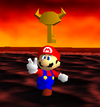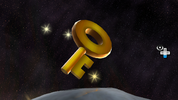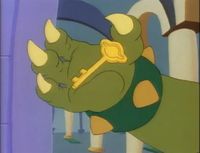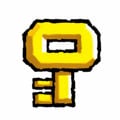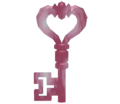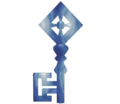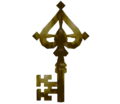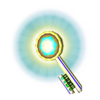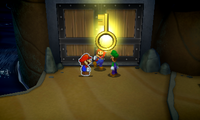Key
- This article is about a general overview of keys. For the specific keys in Mario's Time Machine, see Key (Mainz) and Key (Philadelphia). For the coins simply known as keys in Super Nintendo World, see Key Coin.
Keys in the Super Mario franchise are items and objects typically used for opening locked doors or to unlock secret paths. They have taken on a variety of appearances.
History
Donkey Kong series
Donkey Kong Jr.
In Donkey Kong Jr., keys are used to unlock Donkey Kong's cage in the Chain Scene. In the Game & Watch version, obtaining four keys is a critical component to freeing Donkey Kong.
Donkey Kong (Game Boy)
In Donkey Kong for the Game Boy, keys make their first appearance in Stage 1-1, after Stage 0. In all regular levels of the game except for Stage 0 (which has the stages from the original Donkey Kong arcade game), Mario has to find the key and take it to the correct locked door. Mario picks up the key by standing on it and lifting it above his head. Often, the key has to be thrown upwards because Mario cannot hold it while climbing a ladder, and it can also be used to take out enemies by throwing it.
Super Mario series
Super Mario Bros. 2
Super Mario Bros. 2 is the first Super Mario game to feature keys and locked doors, both first appearing in World 1-2. All keys in this game are guarded by Phantos, one of which will chase the player until the key is dropped or used to unlock a door. Unlike many other items in the game, keys are always visible without having to be rooted up like a vegetable.
Most keys are out in the open, but at least one was guarded by a Birdo in World 7-2.
Super Mario World
In Super Mario World, keys and keyholes can be found in various levels. Bringing a key to a keyhole activates the respective level's secret exit. Like other items in the game, keys can be carried around and dropped or kicked upwards, but they will have no effect on a keyhole unless held by the player. Yoshi can carry a key in his mouth, but will swallow it if it remains in his mouth for too long. The location of a key does not reset when it is scrolled off the screen.
Super Mario 64 / Super Mario 64 DS
In Super Mario 64, there are only two keys, also referred to as Big Keys,[1][2][3][4] in the game, and they can be found in two Bowser levels: Bowser in the Dark World and Bowser in the Fire Sea. Mario gets them when Bowser is defeated. The keys can open the doors of the Mushroom Castle. The first key opens the door to the castle's basement, and the second key opens the door to the castle's upper floors. If the player attempts to open the door to the upper floors with the basement key, a message will appear to let the player know that that key does not fit the lock.
In Super Mario 64 DS, the Big Keys retain their purpose from the previous game, but there are other kinds of keys. First, there are those that rabbits steal. The first key Yoshi has to obtain unlocks the Mushroom Castle; only after he catches the first rabbit can he get inside the castle. There are many other rabbits that can be found in the game, but they unlock only minigames. Three of the second kind of key the player must collect are held by three bosses (Goomboss, King Boo, and Chief Chilly) and are used to free Mario, Luigi, and Wario. The third kind of key is obtained by catching the eight glowing rabbits that randomly appear in place of the regular ones after 50 Power Stars have been collected. The key opens the white-bordered door in the princess's room, which contains a secret Power Star.
Super Mario Advance 4: Super Mario Bros. 3
A Key appears in the World-e level Doors o' Plenty in Super Mario Advance 4: Super Mario Bros. 3. While it is carried in the same way as in Super Mario World, its function is to open Key Doors, as in Super Mario Bros. 2.
New Super Mario Bros. series
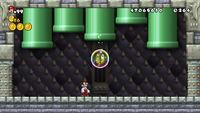
In New Super Mario Bros., at the end of each World from 2 to 7, Mario faces off against a boss. If he wins, a key will be granted.
In New Super Mario Bros. Wii and New Super Mario Bros. 2, when Mario defeats any of the Koopalings at their castles, he will receive a key that he must grab to exit the castle. This item does not serve any purpose other than finishing and closing the level. However, in the Coin Battle mode of New Super Mario Bros. Wii, the player that collects the key receives five coins.
Super Mario Galaxy
In Super Mario Galaxy, keys can be collected to automatically open locked doors or force fields. They are found in galaxies such as the Gateway Galaxy and the Ghostly Galaxy. In the Gateway Galaxy and Ghostly Galaxy, a Grand Goomba and a Boo, respectively, each hold a key which is released after Mario or Luigi defeats the enemies.
Super Mario Galaxy 2
Keys also appear in Super Mario Galaxy 2, and they serve the same function they did in Super Mario Galaxy. They can be found in galaxies such as the Haunty Halls Galaxy and the Battle Belt Galaxy. They also briefly appear in the Rolling Masterpiece Galaxy.
Super Mario Maker / Super Mario Maker for Nintendo 3DS
An update released on March 9, 2016, for Super Mario Maker allowed players to add keys to levels. They can be placed in blocks, or in an enemy, making them obtainable after Mario defeats it. Additionally, another new item included in the update, the Pink Coin, reveals a key once Mario collects every single one in the level. A key does not need to be directly held onto by Mario, as it automatically follows him after obtaining it, similar to the keys in the Yoshi's Island series. Up to eight keys can be obtained at one time.
Super Mario Run
Keys reappear in Ghost House levels in Super Mario Run, with their appearance from the New Super Mario Bros. U style in Super Mario Maker. They are used to unlock Key Doors and can be found inside of Boos and ? Blocks. They are required to beat level 5-3: Boohind Lock and Key.
Super Mario Odyssey
In Super Mario Odyssey, keys make a reappearance, albeit slightly redesigned. They unlock locked panels which contain Power Moons when collected.
Super Mario Maker 2
Keys return in Super Mario Maker 2. In the Super Mario 3D World style, they resemble the key symbols seen on Key Coins in the original game. In multiplayer, a player can stomp on another player who is holding a Key to grab the Key for themselves. If the player holding the Key is defeated, the Key enters a bubble, allowing other players to grab it.
A variant of the key called the Cursed Key was made available with the version 3.0.0 update exclusive to the Super Mario Bros. game style. When a Cursed Key is picked up, a Phanto is spawned.
Super Mario 3D World + Bowser's Fury
Keys reappear now with cat ears in the Bowser's Fury campaign of Super Mario 3D World + Bowser's Fury, appearing specifically when a Key is needed to open a cage containing a Cat Shine. Unlike in previous games, the key must be carried all the way back to the lock, rather than simply touching it. They also disappear if they are on the ground other than their initial spawn point for too long, or if they get thrown into water, the black goop, or lava. In these cases, the key will respawn back at its original location.
Super Mario World animated series
Keys appear in the Super Mario World cartoon in the episodes "Ghosts 'R' Us" and "Mama Luigi". In "Ghosts 'R' Us", when Wizenheimer is defeated, Oogtar uses a ? Block, causing a key to appear, and uses it for the door. In this episode, it makes the same sound as a Cape Feather. In "Mama Luigi", King Koopa shows a key off, gloating that the Mario Bros. will never be able to find Princess Toadstool without it. However, Yoshi then eats it, and after Koopa retreats, he spits it out and it opens the cell the Princess was being held in.
Wario Land series
Wario Land: Super Mario Land 3
In Wario Land: Super Mario Land 3, the player can sometimes find a key inside a Face Block. These keys are hidden throughout many stages of the game and they are required to open the skull door[5] (also called Skeleton Door[5][6] or Treasure Room Door[7]) to a Treasure Room.[5] The keyhole in which the key fits is always found in the same stage as the key and the key can not be taken out of the stage, so it has to be recollected after leaving the level. Inside the Treasure Rooms, Wario can find one of the collectible treasures. However, he cannot be Small Wario as he needs to Body Slam the treasure chest to open it (although breathing fire also works).
Virtual Boy Wario Land
Gate Keys are needed in order to unlock the elevator at the end of each stage in Virtual Boy Wario Land.
Wario Land 3
While being absent in Wario Land II, keys reappear in Wario Land 3. Four differently colored keys are hidden throughout the level: a Gray Key[8] (or Silver Key[9]), Red Key,[10] Green Key,[11] and Blue Key.[12] Wario can only clear a level if he finds one of the keys and manages to take them to their respective treasure chest. By doing so, he earns himself a new treasure that helps the player to proceed and find new levels. Usually, not all keys in a level are available from the start. The player has to obtain new abilities and meet certain requirements to find them all. After a key is taken to a treasure chest, the chest gets replaced by a goal door. After acquiring all treasures in every level and beating the final boss, starting the game will result in Time Attack, in which the objective of every level is to instead collect all four colored keys and exit through one of the goal doors. The fastest possible time will be recorded based on how fast this objective is achieved. Every key can be obtained in a level no matter if it's day or night, so the player won't be locked out of completion in any condition.
Wario Land 4
When Wario Land 4 was in development, Wario originally needed a key to unlock the four boxes (much like Wario Land 3) to gain the four Jewel Pieces. In the final game, Wario merely has to touch the box in order to open it. Besides the Keyzer, no other key is seen in the game.
Yoshi franchise
Keys appear in Yoshi, after the player clears levels 22 through 24 of the B-Type game, rewarding the player with 1,000 points.
In Super Mario World 2: Yoshi's Island (and its reissue), Yoshi's Story, Yoshi's Island DS, Yoshi's New Island, Yoshi's Woolly World, Poochy & Yoshi's Woolly World, and Yoshi's Crafted World, keys can be collected and carried like Yoshi Eggs, taking up one space of the player's maximum number of eggs. They can be used to unlock Mini Battle houses, locked doors in castles, and Corks that block pipes. Additionally, during the cutscene following the defeat of a castle boss, a large key appears and unlocks a keyhole.
In Yoshi's Story, keys are required to open locked doors in the Lift Castle, Ghost Castle, and Magma Castle. They are obtained by defeating a certain ComBat in the Lift Castle, popping a certain ? Bubble in the Ghost Castle, and defeating the two slugs in the Magma Castle. One key in the Ghost Castle is out in the open in an underground section.
Fort Key Calamity (Yoshi's New Island)
Burt the Bashful's Castle (Yoshi's Woolly World)
Donkey Kong Country series
Donkey Kong 64
In Donkey Kong 64, Boss Keys are rewarded after each boss battle, and are used to unlock padlocks on K. Lumsy's cage.
Donkey Kong Country Returns
In Donkey Kong Country Returns, there is a key known as a Map Key that can be purchased from Cranky Kong's Shop in each world, for a total of eight keys. Each key costs 20 Banana Coins, and when purchased, unlocks an alternate route on the world map that will allow Donkey Kong and Diddy Kong to reach additional levels. This totals up to a price of 160 Banana Coins for buying all 8 keys.
Mario Party series
- Main article: Skeleton Key
Bowser owns various keys in the Mario Party series. These so-called Bowser Keys are usually found in Bowser Minigames, and are necessary to escape from Bowser. In earlier Mario Party games, Bowser Keys are simply keys shaped like Bowser's head. In later games, they are engraved with Bowser's likeness. The minigame Locked Out from Mario Party 3 features keys with key heads shaped like mushrooms, flowers and stars.
Paper Mario series
Paper Mario
There are many key designs in Paper Mario and its sequel, but each only opens doors in the area they are found. There are Castle Keys for every castle and fortress, and various others keys in different locations. In Paper Mario, they were used in Tubba Blubba's Castle, Bowser's Castle, and Peach's Castle. Tubba Blubba's keys look like three-leaf clovers, while Bowser's look like a gold three-leaf clover with a blue ball in the middle. There are about three of Tubba's keys and five of Bowser's keys. Peach's Castle Keys are pink versions of Bowser's Castle Keys. Also, a living key called Yakkey locked the Gusty Gulch Windmill.
Paper Mario: The Thousand-Year Door
In Paper Mario: The Thousand-Year Door, the Castle Keys that open the doors in Hooktail Castle are shaped like flowers. There are four Castle Keys. There is also a Grotto Key, which opens the door to the south area in the Pirate's Grotto.
Super Paper Mario
In Super Paper Mario, keys appear more prominently than in the previous installments. They are used in many levels to unlock doors.
Luigi's Mansion series
Luigi's Mansion
In Luigi's Mansion, keys are used to unlock the different rooms of the mansion. Luigi can usually obtain a key by completing a room, then opening a treasure chest. In some rooms, such as the Wardrobe Room or Bathroom, the key spawns on a higher shelf. In the Fortune-teller's Room, Luigi must utilize a specific method to acquire the Laundry Room key, by lighting all four candelabras using the Fire Element Medal.
Special keys
Also, there are four special keys, with each one having a different card suit: heart, club, diamond, and spade.
- The key to Area 2, the Main Hall Key[13] (obtained from Chauncey): This heart-shaped key unlocks the door with the heart imprint on the first floor of the Foyer.
- The key to Area 3, the Courtyard Key[14] (obtained from Bogmire): This key with a club shape on it unlocks the door with the club imprint that is near the Bathroom on the first floor and the Conservatory.
- The key to Area 4, the West Wing Key[15] (obtained from Boolossus): This key with a diamond shape unlocks the second door found on the Balcony on the third floor.
- The key to the Secret Altar, the Secret Altar Key[16] (obtained from Vincent Van Gore): This key with a spade shape on it opens the door that leads to King Boo's Secret Altar, located in the basement at the end of the halls. It's the only special key that's not dropped by a boss Portrait Ghost nor leads to a different area.
Luigi's Mansion: Dark Moon
Keys return in Luigi's Mansion: Dark Moon, with a different design. They are again used to open doors and any key can be used to unlock a door. Keys disintegrate upon being used.
Luigi's Mansion 3
In Luigi's Mansion 3, keys can be found in places across the Last Resort. Their design is complementary to that of the architecture of the Last Resort, and they can be used to unlock locked doors; however, a key can only unlock one door before shrinking into nonexistence.
Mario vs. Donkey Kong
In Mario vs. Donkey Kong, collecting Keys are essential to progress though the levels. Keys need to be carried to locked doors in order to open them and move on to the next area. Like with any other held item in the game, the Key can be thrown forwards and upwards, and will also be knocked out of Mario's hand if he is attacked. Unlike other items, Keys have a twelve-second timer and will disappear and respawn at their original location when the timer is up.
In the Plus Levels, small Keys are attached to Mini Marios. Their purpose is the same as in earlier levels, but Mario cannot pick them up. Instead, they trail behind the Mini Mario as the toy moves. If the Key is brought to the locked door, the stage is cleared, but if the Mini Mario gets damaged, then the player has to restart the level.
In the remake, keys work similarly to its original, but if a player character runs past a key, it will rotate in place. In the newly-added Casual Mode, keys have a fifteen-second timer instead of twelve. Additionally, the remake's bonus stages have flying keys which the player must catch in the given time and bring to a chest containing 5 1-Up Mushrooms.
Super Smash Bros. Brawl
In the Subspace Emissary mode of Super Smash Bros. Brawl, Emissary Keys are found somewhere near locked gates. If the player finds a key and has it in hand while approaching a gate, it will be unlocked.
Mario & Luigi series
Mario & Luigi: Bowser's Inside Story / Mario & Luigi: Bowser's Inside Story + Bowser Jr.'s Journey
Blue Keys, Red Keys, and Green Keys appear as special items in Mario & Luigi: Bowser's Inside Story and its remake, Mario & Luigi: Bowser's Inside Story + Bowser Jr.'s Journey. They are found on the second floor of Peach's Castle, the last stage in the game, held by Fawfulcopters which Bowser must chase after. The Blue Key is required to proceed the storyline; the other two are optional. Earlier in the game, the Stingler and Star Panels behave like keys and open the doors in Pump Works and the Energy Hold, respectively.
Mario & Luigi: Paper Jam
A key briefly appears in Mario & Luigi: Paper Jam, as a teaching tutorial for the Trio Grab. The key is used to open a door in Twinsy Tropics Dungeon.
Captain Toad: Treasure Tracker
Keys appear as items in Captain Toad: Treasure Tracker and its Nintendo Switch and Nintendo 3DS ports. They can be obtained from Pluck Patches, and always open locked doors. They can also be thrown at enemies to defeat them. Akin to other items in the game, Captain Toad and Toadette carry the keys atop their head.
If a stage is cleared while a key is outside its Pluck Patch, the key rewards the player with one coin.
Dr. Mario World
In Dr. Mario World, keys appear as stage objects where they first appear in World 8. The keys in this game are all found inside bubbles, meaning that they will float upwards until they hit an object. The bubbles containing the keys cannot be removed until it comes into contact with a door, after which it will disappear. Like the bubbles in this game, the keys that are currently floating cannot be reacted to, such as when Dr. Petey Piranha's hits the bottom-most objects in each column (therefore the key is not treated as the bottom-most object while floating), except by pushing it upwards with a capsule. Moreover, the Hammer Bro. assistant will affect the floating speed of the key when equipped by slowing down the floating. When a capsule match is made next to the keys, the skill meter will be filled with an extra point for each key that it is made next to, even though the key will not be removed. The keys, as stage objects, appear exclusively in stage mode.
In versus mode, keys are items in which the player can be rewarded by winning versus matches. They are used to unlock battle boxes, of which the player can obtain three out of the nine possible rewards. The default number of keys required to unlock battle boxes is five since version 2.1.0 and seven prior to that, but only three are required on certain weeks. On certain weeks since season 3, specialists have the benefit of winning two keys instead of one if any of them are used to win the match.
The Super Mario Bros. Movie
In the Template:Media link for The Super Mario Bros. Movie, voxelated keys resembling their sprite in Super Mario World can be seen being sold at the antiques store for two coins each.
Profiles
Super Mario Bros. 2
- Wii Virtual Console manual: "This item opens a locked door."
Yoshi's Island: Super Mario Advance 3
- Nintendo 3DS Digital Manual description: "Take a key to a door with a keyhole in it to open it."
Luigi's Mansion series
Luigi's Mansion: Dark Moon
- Instruction Manual description: "Keys open locked doors."
Luigi's Mansion (Nintendo 3DS)
- Instruction Manual description (page 7): "Sometimes while exploring a lit room, you will find a key. Pick it up and use it to open doors to locked rooms."
- Instruction Manual description (page 14): "Open locked doors."
Super Smash Bros. Brawl
- Trophy
- Wii Super Smash Bros. Brawl
- In The Subspace Emissary, there are often locked doors. This key is the item you need to unlock these doors. You can touch a door while holding the key, or you can even throw the key at a door to unlock it. If you lose the key, it will return to the place you originally found it. This item is vital to your progress, so do your best not to lose it.
Gallery
- For this subject's image gallery, see Gallery:Key.
Promotional image for 60-Byō Challenge! Luigi o Sukue!! from Nintendo Co., Ltd.'s LINE account
See also
Additional names
Internal names
| Game | File | Name | Meaning
|
|---|---|---|---|
| Super Mario Galaxy Super Mario Galaxy 2 |
ObjectData/KeySwitch.arc | KeySwitch | Key Switch |
| StageData/ObjNameTable.arc/ObjNameTable.tbl SystemData/ObjNameTable.arc/ObjNameTable.tbl |
鍵スイッチ (Kagi Suicchi) | ||
| Captain Toad: Treasure Tracker | content/ObjectData/DoorLock.szs | DoorLock | Door Key (Japanese kagi can mean key or lock) |
Names in other languages
Key
| Language | Name | Meaning | Notes |
|---|---|---|---|
| Chinese (simplified) | 钥匙[?] Yàoshi |
Key | |
| Chinese (traditional) | 鑰匙[?] Yàoshi |
Key | |
| Dutch | Sleutel[19] | Key | |
| French | Clé[?] | Key | |
| German | Schlüssel[?] | Key | |
| Italian | Chiave[?] | Key | |
| Korean | 키[?] Ki |
Key | |
| Portuguese | Chave[?] | Key | |
| Russian | Ключ[?] Klyuch |
Key | |
| Spanish | Llave[?] | Key |
Treasure Room
| Language | Name | Meaning | Notes |
|---|
Skull door
| Language | Name | Meaning | Notes |
|---|
References
- ^ December 1996. Nintendo Power Volume 91. Nintendo of America (American English). Page 63.
- ^ February 24, 1998. Items | Nintendo: Super Mario 64 Strategy. Nintendo.com (American English). Retrieved February 23, 2018. (Archived March 3, 2000, 13:59:44 UTC via Wayback Machine.)
- ^ Prima Bath (April 7, 1999). Nintendo 64 Game Secrets, 1999 Edition Prima's Official Strategy Guide. Prima Games (American English). ISBN 0761521038. Page 84 and 86.
- ^ Prima Bath (April 21, 1999). Ultimate Nintendo 64 Pocket Power Guide, 1999 Edition Prima's Official Strategy Guide. Prima Games (American English). ISBN 0-7615-2083-X. Page 56 and 57.
- ^ Jump up to: a b c 1994. Wario Land: Super Mario Land 3 instruction booklet. Redmond, WA: Nintendo of America (American English). Page 15.
- ^ Hamm & Rudolf GmbH, Frankfurt (1994). Super Game Boy Player's Guide. Nintendo of America (American English). Page 28.
- ^ September 1996. Nintendo Power Volume 88. Nintendo of America (American English). Page 77.
- ^ June 2000. Nintendo Power Volume 133. Nintendo of America (American English). Page 60, 61, 62, 63, 64, 65.
- ^ Official American Wario Land 3 website. Nintendo.com (American English). (Archived April 29, 2001, 17:27:37 UTC via Wayback Machine.)
- ^ June 2000. Nintendo Power Volume 133. Nintendo of America (American English). Page 60, 62, 63, 64, 66.
- ^ June 2000. Nintendo Power Volume 133. Nintendo of America (American English). Page 61, 62, 64, 65, 66.
- ^ June 2000. Nintendo Power Volume 133. Nintendo of America (American English). Page 65.
- ^ 2001. Luigi's Mansion Nintendo Player's Guide. Nintendo of America (American English). ISBN 1-930206-14-3. Page 29.
- ^ 2001. Luigi's Mansion Nintendo Player's Guide. Nintendo of America (American English). ISBN 1-930206-14-3. Page 46.
- ^ 2001. Luigi's Mansion Nintendo Player's Guide. Nintendo of America (American English). ISBN 1-930206-14-3. Page 62.
- ^ 2001. Luigi's Mansion Nintendo Player's Guide. Nintendo of America (American English). ISBN 1-930206-14-3. Page 75.
- ^ Sakai, Kazuya (Ambit), kikai, Akinori Sao, Junko Fukuda, Kunio Takayama, and Ko Nakahara (Shogakukan), editors (2015). 『スーパーマリオブラザーズ百科: 任天堂公式ガイドブック』. Tokyo, Japan: Shogakukan (Japanese). Page 60, 70, 91, 118, 199.
- ^ --- (2015). 『スーパーマリオブラザーズ百科: 任天堂公式ガイドブック』. Tokyo, Japan: Shogakukan (Japanese). Page 136 and 169.
- ^ Nintendo Nederland (March 9, 2016). Super Mario Maker - Gesloten deuren! Spijkerzuilen! Roze munten! (Wii U). YouTube. Retrieved May 19, 2019.
- Keys
- Bowser's Fury objects
- Captain Toad: Treasure Tracker items
- Donkey Kong objects
- Donkey Kong (Game Boy) items
- Donkey Kong Jr.
- LEGO Super Mario objects
- Luigi's Mansion items
- Luigi's Mansion: Dark Moon
- Luigi's Mansion 3
- Mario Party
- New Super Mario Bros. items
- New Super Mario Bros. 2 items
- New Super Mario Bros. Wii items
- Super Mario 64 items
- Super Mario Advance objects
- Super Mario Advance 4: Super Mario Bros. 3 objects
- Super Mario Bros. 2 objects
- Super Mario Galaxy items
- Super Mario Galaxy 2 items
- Super Mario Maker items
- Super Mario Maker 2 items
- Super Mario Odyssey items
- Super Mario Run items
- Super Mario World objects
- Super Mario World 2: Yoshi's Island items
- Super Smash Bros. Brawl items
- Super Smash Bros. Brawl trophies
- Timber's Balloon Pop
- Virtual Boy Wario Land
- Wario collectibles
- Wario Land 3 items
- Wario Land: Super Mario Land 3 items
- Yoshi's Island DS items
- Yoshi's Island: Super Mario Advance 3
- Yoshi's New Island items
- Yoshi's Woolly World items
- Yoshi (game)


